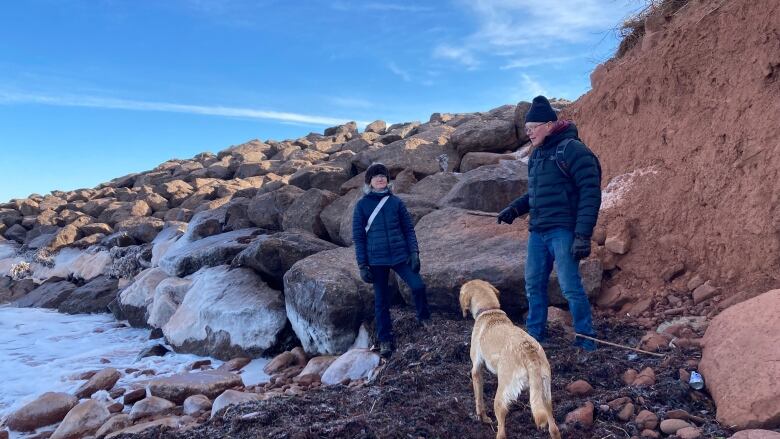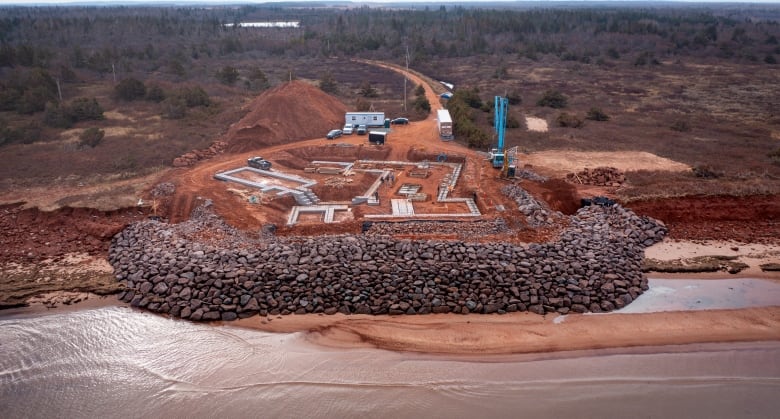Owners of property at Point Deroche argue their new seawall mitigates erosion.

A controversial construction project on the coast of Prince Edward Island has been the subject of residents’ ire for months, thanks to a large stone seawall that critics say severely restricts access to the public beach.
“People who used to walk that beach, well, they can’t walk it…. You’d have to crawl up over armour stone to be able to walk that stretch of beach,” resident Joan Diamond told CBC’s Janna Graham.
Diamond drew up a petition, signed by more than 2,000 Islanders, that calls on the provincial government to halt construction of the seawall and have it removed completely. It surrounds a new vacation home on the Island’s north shore at Point Deroche.
The property’s owners, Toronto couple Jesse and Julie Rasch, have a website of their own, where they have spoken out on what is described as misinformation about the project, arguing it’s “vastly safer to walk around than the old seawall.”
There’s more at stake beyond the beach’s walkability: P.E.I. is slowly eroding, caused in part by high winds and rising sea levels spurred on by climate change — and most recently a battering by post-tropical storm Fiona.
Bryson Guptill, a hiking enthusiast and founder of the Island Walk hiking trail, said that over the last 20 or more years — long before the current barrier’s construction — you could actually measure the shrinking of the sandy beaches next to the property due to erosion.
“Because of all the erosion, it had actually become much closer to the ocean than it used to be,” he said.

“The Island is more vulnerable than any other province. Its shoreline is more vulnerable. And we expect the governments, whoever they are, to respect public trust,” said Guptill, who is also a former senior policy adviser for the federal and P.E.I. governments. “The public trust has been broken here.”
Point Deroche was once the site of a farmhouse and several other buildings. They have since been demolished to make way for a “seasonal residential cottage” comprising four structures totalling 6,740 square feet, as well as a separate 883-square-foot bunkie further away from the coast.
The old house had a seawall, too. But critics say the new one makes it more difficult for residents to traverse the public portions of the beach.
In a statement, the P.E.I. government told CBC News that the new seawall is on the same footprint as the old farmhouse’s seawall.
Property owners dispute critics’ arguments
“It is regrettable to see the politicization of our cottage development,” the Rasch family told CBC News in an emailed statement.
“Our work has been lawfully approved, and it will be respectfully seen through to completion. We love P.E.I., and would be pleased if the discussions spurred by our cottage lead to changes that Islanders feel best serve all the stakeholders involved in permitting shorefront property development.”
“There are still people who believe the beach has been blocked by our work; this lie was repeated often in recent weeks, and we don’t expect everyone to embrace the truth,” Jesse Rasch said in a separate email.
“The new shoreline system modestly improves beach access, and significantly improves safety and sight lines, for the infrequent public visitors to this remote area,” the Rasches said.
On their website, they argue that their seawall “likely … mitigated damage” to the coast by Fiona last September. But government officials, including P.E.I. Environment Minister Steven Myers, have suggested the opposite.
“There’s nothing that would protect the adjacent shoreline. I think it’s part of the crux of the Point Deroche argument, is if you look at the pictures post-Fiona, it’s really accelerated the erosion next to it,” Myers said in the provincial legislature last November.
Stop work order issued, then rescinded
The province issued a stop work order on the development in September 2022, according to a Freedom of Information request submitted by Guptill. It cited “significant encroachment on an environmental buffer zone,” which is protected by P.E.I.’s Planning Act.
But that order was later rescinded after provincial staff met the developer on-site and concluded that the plans complied with regulations.
In a statement to CBC News, the province said the development was permitted in a “working policy” agreed on by the Department of Environment, and the Department of Agriculture and Land.

The policy states that existing structures on the property are allowed to stay as is, but new modifications or additions to the property cannot extend closer to the coast, beyond a prescribed boundary. CBC News has asked to see this policy multiple times, with no response.
But critics, including Myers, Guptill and the Canadian Meteorological and Oceanographic Society, point out that the beach in front of and next to the wall has eroded over the past few decades.
As a result, the water is now closer to the wall, even if the property itself hasn’t gotten bigger — a dilemma the working policy doesn’t directly address.
“I don’t blame the land developer, the company that did this. I mean, they’re trying to make a buck,” Guptill said. “I blame the government.”
Seawall erosion
Seawalls are coastal defence systems, made of hard materials like concrete, boulders and steel. They were once a common method of protecting a home, but these days, scientists generally agree that they’re actually destructive.
A recent report by the United Nations Intergovernmental Panel on Climate Change found that even though seawalls might reduce impacts to people and buildings in the short term, they can cause long-term exposure to climate risks.
That’s because they can block the natural movement of waves that would otherwise replenish beaches, causing damage to wildlife habitats and trouble for people living nearby.
Top among the concerns is beach loss — both in front of a seawall and beside it — in a phenomenon called flanking erosion.

“The dynamic of the waves shoots to the edges. And on both sides of the development, there’s an extraordinary amount of erosion,” Guptill said.
Coastal erosion is already a major concern on P.E.I. Drone footage gathered by CBC News last year showed “unprecedented” and “heart-wrenching” erosion along the coastline after Hurricane Fiona.
The Rasches’ site mentions a plan for “naturalizing” the seawall by using native soils, growing indigenous plants and “strategic” placement of boulders and logs to help stabilize the surrounding area, “reducing erosion.”
But it’s unclear how long that will take, or how effective any of this will be — especially in the event of another storm like Fiona.
Krummholz and ‘living shorelines’
The Point Deroche controversy has put broader concerns about just how vulnerable P.E.I. is to climate change under a microscope. What’s more, the Island’s very foundation is built upon sandstone, which is prone to erosion or even crumbling.
Daniel McRae, a researcher with the Macphail Woods Ecological Forestry Project, said one possible solution already exists on the Island: “living shorelines” made of plants known as krummholz.
“It’s a German word in origin, and it stands for ‘bent wood,'” he explained.

‘Living shorelines’ may help mitigate future climate damage
P.E.I. is rebuilding its shorelines after Hurricane Fiona by replanting a living shoreline, which absorbs the force of waves and may be part of the solution in future-proofing against climate disasters.
Krummholz aren’t a specific species of plant; they’re more like a selection of trees and shrubs that grow on coastal, windswept areas like much of P.E.I.
Instead of deflecting erosion like a more traditional seawall would do, a natural, living shoreline made of krummholz can diffuse the wind, McRae said.
“They end up protecting both the shoreline erosion as well as the inland forest behind them,” he said.

Living shorelines happen naturally, but they can also be encouraged or helped along by humans. McRae said he thinks reforesting the shoreline near or around Point Deroche can help mitigate the erosion that’s already occurred.
But he cautions that its effects will likely be seen and felt on a more long-term time frame and aren’t an immediate solution to the current seawall controversy.
So far there is no mass scale effort to plant or enhance krummholz. However, P.E.I.’s Building Resilience: Climate Adaptation Plan, released in October 2022, includes a call to “develop a program to support nature-based solutions to erosion and flooding for lower-income individuals.”

In the meantime, advocates like Bryson Guptill and Joan Diamond are resolved to continue petitioning the government to take action in the interest of their homes.
“We live on an island. It’s basically a little sandbar in the middle of the ocean, right? We know that those … stone walls erode everything around it,” Diamond said.
“Point Deroche will eventually be sitting out in the middle of the ocean.”
Radio documentary produced by Janna Graham. With files from CBC P.E.I.
*****
Credit belongs to : www.cbc.ca
 Atin Ito First Filipino Community Newspaper in Ontario
Atin Ito First Filipino Community Newspaper in Ontario






